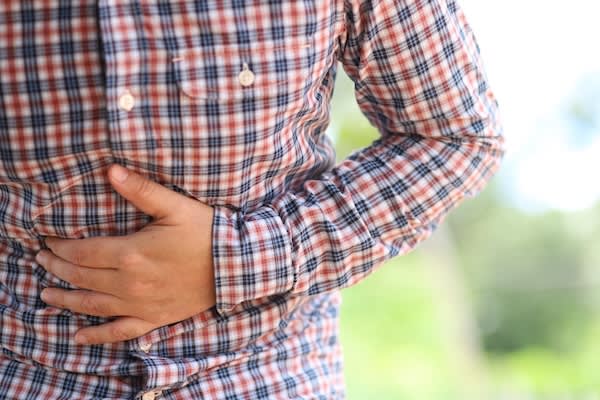Upper abdominal pain: Causes, symptoms and relief
[8 MIN READ]
In this article:
-
Upper abdominal pain is very common and affects many people. Some conditions that cause pain are minor, but others can be serious. Know which symptoms require medical attention.
-
Common causes of upper abdominal pain include digestive issues like acid reflux and constipation, muscle strains, stress and anxiety. These typically go away on their own, but over-the-counter pain relievers can help.
-
See your doctor if you have pain that doesn’t go away within a few days. Seek immediate medical care if you have warning signs such as severe or sudden abdominal pain; blood in your urine, poop or vomit; difficulty breathing; high fever; or pain that radiates to your back or chest.
Upper abdominal pain: Understanding causes, symptoms and when to seek care
Upper abdominal pain, or upper gastric pain, is common. Many conditions can cause upper belly pain – from minor to more serious. It’s important to pay attention to the type of pain and your symptoms and know when to seek medical care.
Understanding your upper abdomen anatomy
Doctors divide the abdomen into regions to help diagnose problems based on symptoms and their location. “From the breastbone to the belly button is the upper abdomen, and below the belly button is the lower abdomen,” says Daniald M. Rodrigues, M.D., a gastroenterologist at Providence Center for Digestive Health – Mission Viejo. “We also split the abdomen into right, center and left sides.”
The organs in the upper abdominal region include:
- Duodenum (part of your small intestine)
- Gallbladder
- Liver and bile ducts
- Pancreas
- Part of your colon (large intestine)
- Spleen
- Stomach
Common causes of upper abdominal pain
There are many reasons you may have upper abdominal pain. Some of the most frequent are digestive issues, muscle strain, stress and anxiety.
Digestive issues
You may feel abdominal pain after eating. The most common causes include:
- Acid reflux and GERD: Stomach acid moves into your esophagus and causes heartburn. GERD, or gastroesophageal reflux disease, is chronic acid reflux.
- Constipation: This is difficulty pooping or having less frequent bowel movements.
- Indigestion and gas: Indigestion is also called dyspepsia. Backed up food or gas can accumulate in the digestive system and cause bloating or a bowel obstruction.
Although these conditions can be uncomfortable, they typically go away on their own. Over-the-counter (OTC) medicines such as antacids can relieve discomfort.
Muscle strain
You can get pain when a muscle in the abdomen stretches or has a minor tear from exercising or coughing. Over time, pain generally decreases with rest or gentle massage.
Stress and anxiety
Dr. Rodrigues says that stress and anxiety are common causes of upper abdominal pain. “There are many nerves going from the brain to the belly, which can make us feel like we have butterflies in our stomach when we’re tense. Also, stress activates our ‘fight or flight’ response and can make us more sensitive to gas in our stomach. Plus, chronic stress increases cortisol levels, which can lead to stomach ulcers.”
Upper abdominal pain by location
Your symptoms and the location of your upper abdominal pain can help your doctor identify and treat the cause.
Left upper quadrant pain
In your upper left abdomen, you can feel stomach issues such as:
- Gastritis and peritonitis, which are inflammation of the stomach lining
- Gastroparesis, which slows or prevents digestion
- Indigestion or dyspepsia
- Peptic ulcers, or sores in the stomach lining or duodenum
- Stomach viruses like gastroenteritis (stomach flu)
Besides pain, symptoms depend on your condition, but may include:
- Appetite loss
- Bloating
- Feeling of fullness
- Nausea
- Vomiting
Spleen-related issues also can cause left upper quadrant pain. An infection or liver disease can lead to an enlarged spleen. A trauma or injury can cause your spleen to rupture, which is a life-threatening emergency.
Additional signs of spleen problems may include:
- Anemia
- Dizziness or lightheadedness
- Fatigue
- Frequent infections
- Left shoulder pain
Right upper quadrant pain
Pain in the right side of your stomach or upper abdomen has various causes. Among them:
- Gallbladder conditions: Gallstones, gallbladder inflammation, a tumor in the gallbladder or bile ducts, and injury to (or inflammation of) the bile ducts can cause pain. Other symptoms include fever or chills, nausea or vomiting, dark-colored urine, fatigue, and pain in your right shoulder.
- Kidney issues: Kidney infections or kidney stones can cause vomiting, chills, fever, and blood in your urine. Pain usually occurs in the lower abdomen, but can radiate to the upper abdomen.
- Liver conditions: Hepatitis (a liver infection) and a liver abscess can be painful. Other symptoms may include nausea and vomiting, yellowing of your skin (jaundice), fever, joint pain, and dark-colored urine.
Center upper abdominal pain (epigastric)
The epigastric region is between your ribs and belly button. Stomach issues that impact the left upper quadrant also can cause pain in the upper tummy region.
Pancreas concerns such as pancreatitis (inflammation of the pancreas) or pancreatic cancer impact this area. Signs of pancreatitis may include fever, nausea, vomiting, rapid pulse and sudden weight loss.
When upper abdominal pain might be serious
Some conditions of upper abdominal pain go away on their own or OTC medicine. Others, such as peptic ulcers, gallbladder disease and pancreatitis, need medical attention. They can become life-threatening.
Sometimes, upper abdominal pain may be related to your heart. “Epigastric pain can be a sign of an issue in the lower part of the heart, like angina or a heart attack,” Dr. Rodrigues says. “It can feel like an elephant sitting on your chest, and it worsens with activity. Don’t ignore this.”
Chest pain and heart-related upper abdominal pain also can be due to a chest infection, pericarditis (infection of the lining of the heart) or a pulmonary embolism.
Warning signs that require emergency care
Contact your doctor if you have severe abdominal pain, or if it lasts more than a few days. “People often overlook abdominal discomfort or try to deal with it on their own,” Dr. Rodrigues says. “But any time you have increasing intensity or frequency of pain, it may be a sign of something serious. Get it checked out sooner rather than later.”
There are many warning signs that require medical attention. These include:
- Abdominal pain during pregnancy
- Blood in your urine, poop or vomit
- High fever
- Inability to poop
- Jaundice
- Pain radiating to your back or chest
- Severe or sudden abdominal pain
- Shortness of breath
- Unexplained weight loss
- Visible swelling or hardness of your belly
“Anytime you’re feeling that something’s not right, see your doctor,” Dr. Rodrigues recommends. “Never overlook any bodily symptom. Get it checked out just to be safe.”
When to see a Providence provider
The expert gastroenterology team at Providence can help. They use the latest diagnostic techniques and treatments to ease your discomfort. “We offer comprehensive care with many subspecialities, gastrointestinal doctors on call 24/7 and extensive follow-up,” Dr. Rodrigues notes.
If your symptoms are mild to moderate, you can schedule an appointment with your doctor or access virtual care options.
But if you have more severe pain or experience any of the warning signs above, find urgent care near you or go to the emergency room at the closest hospital.
Contributing caregiver

Daniald M. Rodrigues, M.D., is a gastroenterologist at Providence Center for Digestive Health – Mission Viejo in Mission Viejo, California.
Find a doctor
If you are looking for a primary care provider or gastroenterologist, you can search for one who’s right for you in our provider directory. You can also find out more about our gastrointestinal services.
Download the Providence app
It’s all in the app: easily stay connected with Providence and your health. With the Providence app, you can schedule appointments, have virtual visits from the comfort of your own home, get health recommendations personalized for you, access your health records and so much more. Learn more and download the app.
Related resources
Left side stomach pain: When it’s time to see a doctor
When to see your doctor about lower abdominal pain
Signs your stomach pain isn’t normal
This information is not intended as a substitute for professional medical care. Always follow your health care professional’s instructions.
